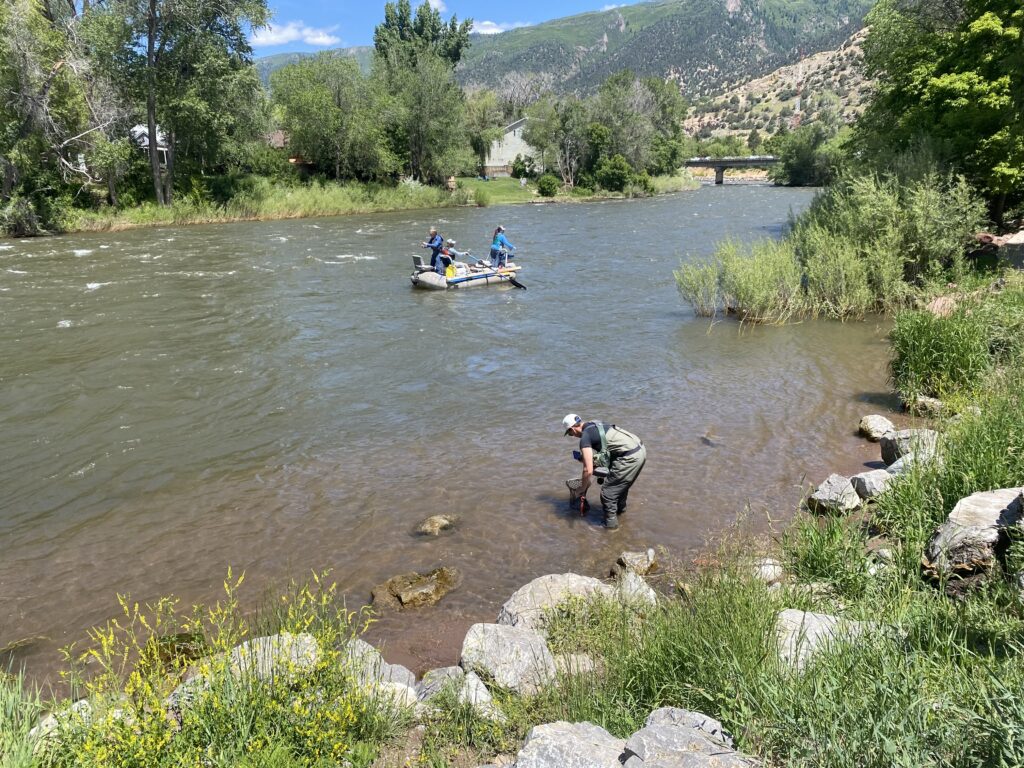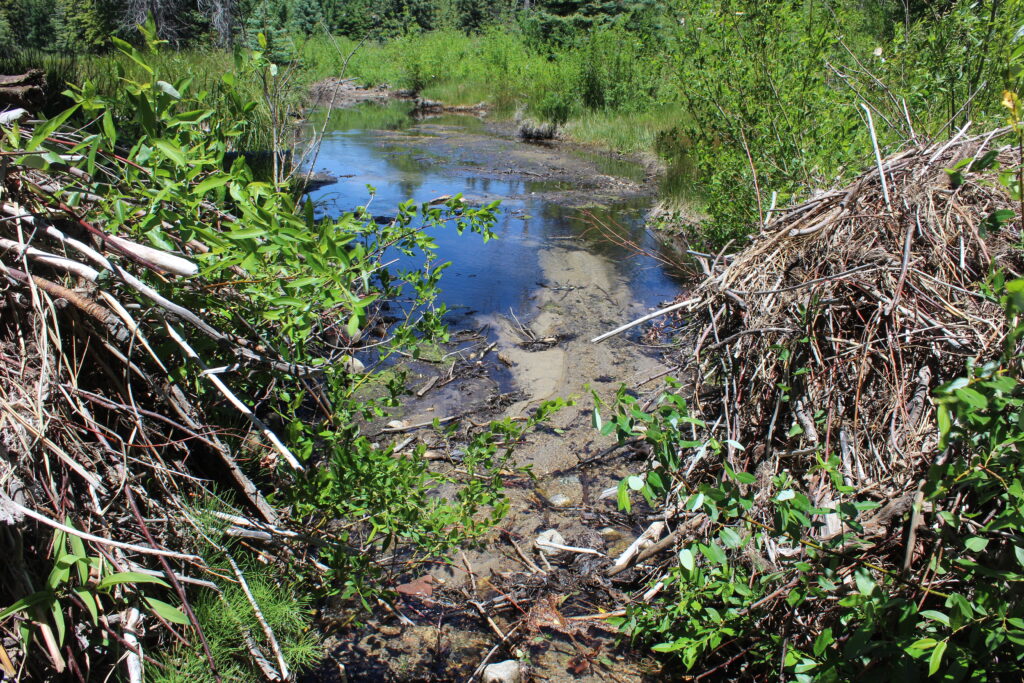As the Roaring Fork and Colorado rivers heat up, managers try to keep fish cool
Caroline Llanes
Aspen Public Radio

The confluence of the Roaring Fork and Colorado rivers in Glenwood Springs shows the differences between the two rivers in color and chemistry. But both have faced lower flows and warmer temperatures in recent years, impacted by human caused climate change.
At the confluence of the Roaring Fork and the Colorado River in Glenwood Springs, it’s clear that a big, snowy winter has turned into a big spring and summer for local streamflows, too.
On June 23, the water was 50 percent higher than it was at the same time last year, flowing twice as fast, according to a sensor monitored by the U.S. Geological Survey. Provisional data shows the water was colder, too, by a few degrees Celsius.
That’s all good news for the fish that call these waters home — at least for now.
“My impression is that it’s a good year in a bad pattern,” said Clay Ramey, a fisheries biologist with the White River National Forest, in an interview in the U.S. Forest Service office in Aspen.
“It gives all these animals a year to get off a strong age class, and kind of brace themselves for the next round of drought,” he said. “So it’s really kind of a gift to the streams and all the critters that live in it.”
Ramey wades into rivers, streams, and creeks from Meeker to Aspen, including the Roaring Fork River.
He said most of the fish in the Roaring Fork are coldwater fish, like rainbow and cutthroat trout, and these fish have dealt with a difficult couple of years.
The water has been warmer, and there’s been less of it — not just here, but in other waterways in the White River National Forest too.

“2018 had very low water,” Ramey recounted. “So we would go to streams in early June or early July and the streams were at a pretty fair September level flow, and then it didn’t rain all summer. So they just got lower and warmer, you know, right from day one. And coldwater fish do not thrive in that environment.”
The Roaring Fork watershed is in the Upper Colorado River Basin, which includes parts of Colorado, New Mexico, Utah and Wyoming. And between 2000 and 2014, streamflows in the Upper Basin were nearly 20% lower than the last century’s average, the worst 15-year drought on record.
Researchers from the Colorado River Research Group in Boulder estimate that between one-sixth and half of that loss was due to warmer temperatures — nearly one degree Celsius hotter than averages in the 20th century.
Their study reported that those higher temperatures were tied to human-caused climate change and increased greenhouse gas emissions, and that “future climate change impacts on the Colorado River will be greater than currently assumed.”
Data from the Western Water Assessment through the University of Colorado Boulder shows similar patterns on the Roaring Fork River.
Since the year 2000, streamflows have been 13% lower on average than the 20th century — even though the amount of rain or snow falling didn’t change that much.
Wildlife managers have seen the impacts firsthand, throughout an interconnected river system.
In 2019, Ramey was counting cutthroat trout in West Divide Creek, which flows into the Colorado River near Silt. In a 100-meter stretch of stream, where fish-counters used to find 30 to 40 adult fish, Ramey said they found just one during that count.
Another coldwater species, the mountain whitefish, is struggling too. They’re native to other Northwest Colorado rivers and were introduced to the Roaring Fork in the 1940s.
And their populations here have plummeted in the past 15 years or so, which researchers attribute to warmer temperatures in the Roaring Fork River, along with increased sediment flushes from monsoon rain events. One of those researchers is Kendall Bakich, an aquatic biologist for Colorado Parks and Wildlife.
“From what used to be one of the most abundant fishes in the Roaring Fork River is now very, very sparse,” she said. “We used to catch over 60 to 100 whitefish per acre and we’re down to less than 10 in our surveys.”
She said higher temperatures can also impact the whitefish’s ability to lay eggs that can actually survive to hatch.

Stressful conditions cause CPW to enact voluntary fishing closures in an effort to reduce the stress that anglers put on fish. But she says in these conditions, most of them wouldn’t want to go fishing anyways.
“Part of the fun of fishing is … fighting the fish, bringing it in and [having] it, you know, being really sassy on the line,” she said. “But the fish just kind of roll over, and they come in and they’re not not energetic. … You just don’t feel like they’re doing well. And even if it’s been like a short fight or very limited handling, anglers recognize that it’s not enjoyable for them anymore and they recognize that it’s stressful for the fish.”
Ivan Perrin, a local fishing guide, knows the feeling.
He’s been a fishing guide with Roaring Fork Anglers in Glenwood Springs for more than 30 years.
Sitting down in the Glenwood Springs shop, he recalled a moment of disappointment he felt in one of his favorite spots on the Colorado River, in a place called “the Horse Crossing” between Silt and Rifle.
“One day, late in the summer, during the time where you have to understand how to handle the fish after the stress point and know that it’s okay to be released and be okay, I came into the run and there were four large rainbow trout, bellyup on the bottom of the river,” he recounted.
Perrin said whatever angler caught those fish didn’t give them enough time to recover before releasing them back into the water.
“And the disappointing thing is those were 18 to 20 inches,” he said. “They were trophy fish for anybody that comes here. And there were four of them. So it was disappointing.”
These days, Perrin tries to promote limited human contact with the fish — less handling, not as many photos — so anglers can continue doing what they love with more recognition of the condition of their catch.
But there’s only so much individual anglers and recreationists can do for fish populations with the changing climate.
Ramey, the fisheries biologist, says fish might not be able to handle a short fight with an angler if they’re swimming in conditions they’re not suited to, like the wrong water temperature or chemistry.
“They’re having to spend more effort just to be alive, to regulate their metabolism and just to function as an organism,” he said.
Researchers with the Western Water Assessment and Colorado River Research Group are predicting that warming trends will continue, and streamflows will continue to be lower.
And that trend is dependent on the level of greenhouse gas emissions we can reduce in the coming years.
Under the Western Water Assessment’s lower-emissions scenario, temperatures could rise by as much as 6 degrees by 2050, and reduce streamflows in western Colorado and the Roaring Fork River by as much as 20 to 30%.
So right now, Ramey and the Forest Service are looking for more landscape-wide solutions that can help address environmental stressors.
Those are a little harder to find, but Ramey said there could be some opportunities to make riparian habitats more resilient in the face of a changing climate.
One of those could be described as a furry silver bullet.
“Making sure that the beavers are happy and occupying as many places as they can is arguably the best thing we can do to help these stream ecosystems and these headwaters,” Ramey said.
Overall, Ramey said, beavers just make a habitat better, particularly in an ecosystem like the Roaring Fork watershed that’s primarily driven by snowmelt.
He says that after high spring runoff, streamflows dwindle as the year goes on.
But beaver dams regulate the flow of water to stream ecosystems throughout the summer, making conditions better later on when flows are typically lower.
Dams also help stabilize river banks and allow for trees to grow that create much needed-shade, which cools streams down. They also create beautiful, diverse fish habitats.
“And that’s not adding a new thing to create new features,” Ramey said. “It’s just protecting and sustaining or reestablishing what was the natural order of things before we disturbed that.”
The White River National Forest will be undertaking significant efforts to study beaver presence in the Roaring Fork watershed this summer. Seasonal workers will hike throughout the watershed using aerial mapping as a guide to determine where beaver dams already are, and where they could be beneficial in the future.
Then, forest managers can make beaver-related plans, whether that’s physically getting more beavers into the watershed, or creating beaver dam like structures to serve the same function.
These efforts will make a long-term difference, while the strong runoff from this year’s snowy winter helps give stressed fish a break — at least for now.
Editor’s note: This story is part of Aspen Public Radio’s four-part series, “Adaptation: Responding to Climate Change in the Roaring Fork Valley.”
The series is supported by a grant from the Aspen Skiing Company’s Environment Foundation. If you have a story idea for our ongoing climate coverage, please reach out to news@aspenpublicradio.org.

